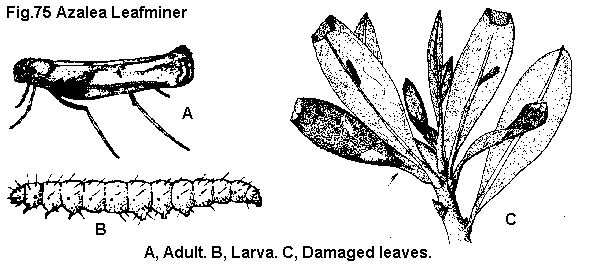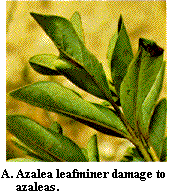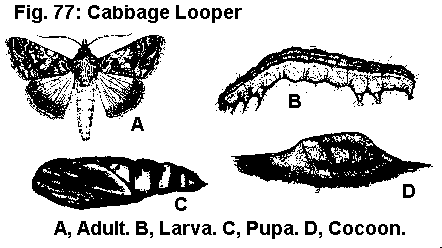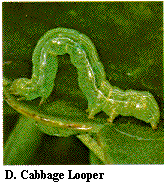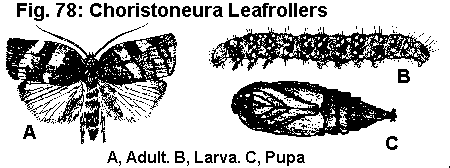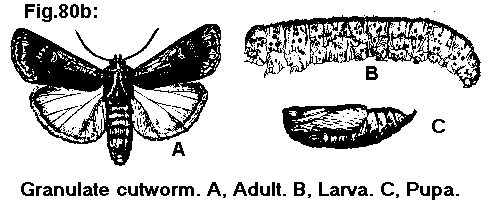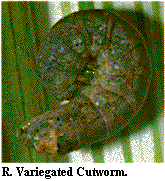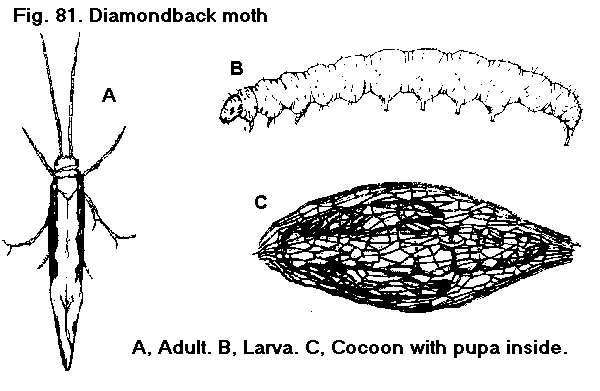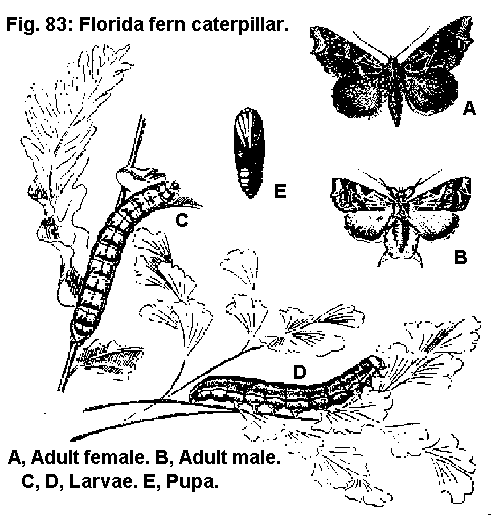Key to Most Common Caterpillars Found on Flowers and Foliage
-
Small, slender caterpillar mining in the leaves or folding the tips of the leaves of azaleas (Figure 62) - AZALEA LEAFMINER
Not mining the leaves or folding the tips of leaves of azalea - GO TO 2 -
Young larvae mine in leaves and later burrow into the stem, petioles, flowers, or seed pods of geranium and snapdragon (Figure 63) - PLUME MOTH CATERPILLARS
Not mining in leaves and burrowing into the stem, petioles, flowers, or seed pods of geranium - GO TO 3
-
Variously spotted and marked caterpillars feeding on the foliage of ferns (Figure 64) - FLORIDA FERN CATERPILLAR
Not feeding on ferns - GO TO 4
-
Whitish caterpillar feeding on and within the rhizomes of iris (Figure 65) - IRIS BORER
Not feeding on or within the rhizomes of iris - GO TO 5
-
Relatively slender caterpillar (Figure 66) feeding only on plants in the mustard family (Cruciferae), at least 4 pairs of prolegs, prolegs relatively long, one row of crochets around the end of each proleg, usually feeds under leaves, riddling the foliage; when disturbed often hangs down by a silk thread - DIAMONDBACK MOTH
-
Boring into the stalks of garden mums and shasta daisies and other stems of flowering crops (Figure 67) - EUROPEAN CORN BORER
Not boring into the stalks of garden mums, shasta daisies, and other stems - GO TO 7
-
Tying or rolling the leaves of the host plant with silk strands - GO TO 8
Not tying or rolling the leaves of the host plant with silk strands - GO TO 11
-
Tying or rolling the leaves of canna - GO TO 9
Not tying or rolling the leaves of canna - GO TO 10
-
Caterpillar slender, up to 23 mm long with yellowish head (Figure 68) - LESSER CANNA LEAFROLLER
Caterpillar relatively robust, green, somewhat transparent, brown head on a distinct neck - LARGER CANNA LEAFROLLER
-
Shield on first thoracic segment only slightly darker than rest of skin but with a distinct dark spot on either side; there are two prespiracular setae on the first thoracic segment; caterpillar green and sometimes with a darker green stripe along the back and a paler green stripe along either side (Figure 69A); prolegs with crochets in arranged in circles with three rows on the inside but one row on the outside (Figure 69B); no anal fork - GREENHOUSE LEAFTIER
Not as above; three prespiracular setae on first throacic segment, anal fork or comb present on last abdominal segment (Figure 70); crochets on last pair of prolegs not in a complete circle - CHORISTONEURA and PLATYNOTA LEAFROLLERS
-
Caterpillar with only two pairs of prolegs (plus 3 pairs of legs on the thorax, Figure 71), loops as it travels on plant; feeds on leaves and flowers - CABBAGE LOOPER
Caterpillar with five pairs of prolegs on abdomen (plus three pairs of legs on thorax), does not loop as it travels along; feeds on various parts - GO TO 12
-
First and second instars are pale green with dark heads; older caterpillars are green to almost black with stripes along each side; always have a black spot on the side above the second pair of legs (counting from the head, Figure 72) - BEET ARMYWORM
Caterpillar variously colored but never with a black spot on the side above the second pair of legs (counting from the head) - GO TO 13
-
Primarily a pest of buds and flowers, caterpillar remains on plant during the day (Figure 73) - CORN EARWORM
Primarily a pest of foliage; caterpillars (especially older caterpillars) tend to hide in the soil or potting mix during the day (Figure 74A, 74B, 74C) - CUTWORMS
Azalea Leafminer
Azalea leafminer (Figure 75), Caloptilia azaleella (Brants), Gracillariidae, LEPIDOPTERA
DESCRIPTION
Adult
The adult azalea leafminer is a small yellow moth with purplish markings on the wings. The wingspread is about 10 to 13 mm.
Larva
In the larval stage, the azalea leafminer is a yellowish caterpillar about 7 to 13 mm long. It has three pairs of prolegs found on abdominal segments 3, 4, and 5. The proleg hooks (crochets) on each proleg are arranged in a U-shaped pattern (penellipse) with another series of crochets within the U-shape.
BIOLOGY
Distribution
The azalea leafminer is found in most states where azaleas are grown.
Host Plants
Azaleas are the only known hosts for this insect.
Damage
Injury is usually not apparent until brown blisters appear in the leaves or until the tips and margins of leaves are rolled and damaged by feeding larvae inside (Figure A). Seriously injured leaves usually turn yellow and drop, thereby causing an unsightly plant. Azalea leafminers usually cause little damage in the field but may do considerable damage to cuttings or potted plants being forced into bloom in the greenhouse.
Life History
Eggs (usually one to five per leaf) are deposited singly on the underside of the leaf along the midrib. The young larvae hatch in about 4 days, mine into the leaf, and feed between the two leaf surfaces. At this stage the leaf appears to have blisters on it; if it is held up to the light, the larva may be seen inside. When about one third grown, the larva emerges, moves to the tip of a new leaf, and rolls it up for protection while feeding and growing. When nearly grown, the larva rolls up the margin of a leaf and spins a cocoon inside. The moth emerges from the cocoon, mates, and deposits eggs for another generation. Development takes about 6 weeks. Under greenhouse conditions the larva may be found anytime during the year. Outdoors, the insect overwinters as a larva or pupa. Adults appear and females begin to lay eggs about the time azaleas bloom in the spring.
CONTROL
Because the larva protects itself by mining into and rolling the leaf, this insect is not easy to control. Chemical control is possible if applied at the first sign either of the moths or of foliar injury by the larvae. One or two applications, 1 to 2 weeks apart should give adequate suppression. For chemical control recommendations, consult the current Cooperative Extension publications on ornamental plant pest management.
Beet Armyworm
Beet armyworm (Figure 76), Spodoptera exigua (Hubner), Noctuidae, LEPIDOPTERA
DESCRIPTION
Adult
The beet armyworm adult is a grayish brown moth with a pale circular spot near the middle of the forewing. The wingspan is 25 to 30 mm. The hind wings are whitish with dark edges.
Larva
First and second instars are pale green with dark heads. Older caterpillars are green to almost black with stripes along each side. Beet armyworms always have a black spot on the side above the second pair of legs (counting from the head).
Pupa
At first the beet armyworm pupa is light brown, but it soon darkens.
BIOLOGY
Distribution
The beet armyworm originated in southern Asia and has since spread throughout most temperate and tropic countries.
Host Plants
The beet armyworm has an extremely wide host range including numerous ornamental crops such as roses and geraniums. Chrysanthemums, carnations, and Gypsophila are especially preferred.
Damage
Beet armyworms web foliage together and feed within this shelter. They also bore into flower buds. Older larvae feed extensively on flowers, buds, and foliage.
Life History
The beet armyworm has several generations per year. Flight activity is greatest in July and August. Eggs are laid in masses of 15 to 150 mostly on the undersides of leaves and mostly within 10 cm of the soil surface. Females may cover the eggs with a mat of scales that protects them from parasites and insecticides. Females prefer younger plants to older plants. Two to 9 days later the eggs hatch. First and second instar beet armyworms feed in groups, especially in the growing tips where they web several leaves together. Older larvae do not restrict feeding to young leaves. The third and fourth instars last 1 to 3 days. The fifth instar feed for 2 to 6 days. Beet armyworms are cannibalistic, particularly when feeding on plants with low nitrogen levels. Moths that develop from cannibalistic caterpillars lay more eggs than moths that developed from caterpillars that fed only on plant material. Mature beet armyworms tunnel into the soil 2.5 cm and form a cell in which they pupate. The pupal stage lasts 4 to 11 days. The moths are nocturnal and mating and egg laying occur at night. Females deposit up to 600 eggs during their 7- or 8-day life. Moths may live up to 30 days.
CONTROL
Cotesia marginiventris (Cresson) is a common parasite of the beet armyworm. Meteorus laphygmae Viereck, Pristomerus spinator (Fabricius), Campoletis flavicincta (Ashmead), and Chelonus insularis Cresson also parasitize the immature stages of the beet armyworm. A polyhedrosis virus sometimes causes epizootics in beet armyworm populations that causes virtually 100 percent mortality in some fields.
The beet armyworm is difficult to control with chemicals because the young larvae webs leaves together and feed under the webbing that protects them from insecticides. Older larvae are more tolerant of pesticides. In addition, some beet armyworm populations have acquired resistance to methomyl and perhaps other pesticides. Pheromone traps can help monitor for moth flight activity. All Bacillus thuringiensis strains are not necessarily acutely toxic to beet armyworms, but some strains do cause significant mortality and stunt the development of surviving caterpillars. The use of bacterial pesticides may help delay the acquisition of resistance to pesticides by the beet armyworm. For specific chemical control recommendations, consult the current Cooperative Extension publications on ornamental plant pest management.
Cabbage Looper
Cabbage looper (Figure 77), Trichoplasia ni (Hubner), Noctuidae, LEPIDOPTERA
DESCRIPTION
Adult
The adult cabbage looper is a grayish-brown moth with a wingspan up to 33 mm. The forewings have a distinct irregular, white mark.
Egg
When first deposited, the eggs are white but darken as they get older. The eggs are hemispherical with fine transverse lines and longitudinal ribs.
Larva
Newly hatched larvae are whitish with a black head and shield immediately posterior to the head. As the larvae grow, they become light green with two dorsal white stripes and two wider lateral white stripes (Figure D). The markings become less distinct in the last instar. The body tapers toward the head, and the full grown larva is 35 to 40 mm long.
Pupa
Easily seen through the webby cocoon, the pupa is light green when first formed and darkens to almost black later.
BIOLOGY
Distribution
The cabbage looper is found throughout the United States.
Host Plants
The cabbage looper larva IS a general feeder with a wide range of possible food plants. Some hosts are cabbage, carnation, snapdragon, nasturtium, mignonette, celery, tomato, beet, pea, and lettuce.
Damage
On some plants the larva has a distinctive feeding habit. The holes it makes are arc-shaped. The area of the hole is determined by the size of the larva that made it. The characteristic pattern is caused by the larva partly cutting the leaf as far as it can reach by holding fast with its hind legs.
Life History
Because the larva of the cabbage looper lacks 2 pairs of prolegs, it is necessary for the caterpillar to arch its back in a looping fashion to move, hence the common name looper.
Eggs are deposited singly on either side of the leaf by the cabbage looper. Each female is capable of producing 200 or more eggs. Hatching occurs 3 to 10 days after the eggs are laid. There are four or five larval instars that develop in 10 to 50 days. If food is abundant and environmental conditions are favorable, only four instars develop. The larvae are strong crawlers and will travel some distance to reach a new host. If disturbed, the caterpillars characteristically curl into a ball and drop from the plant. Pupae are formed within a thin, white cocoon that may be attached to different objects or under a clod of soil. The pupal stage lasts from 6 days to as long as several months (overwintering stage). The adults are strong fliers and are active about dusk and on cloudy and cool fall days. The moths avoid strong sunlight.
CONTROL
A number of parasitic wasps and flies attack cabbage looper caterpillars, and birds and bats feed on the adult moths. For specific chemical control recommendations, consult current Cooperative Extension publications.
Choristoneura Leafroller
Obliquebanded leafroller, Choristoneura rosaceana (Harris), Tortricidae, LEPIDOPTERA
Spotted fireworm (Figure 78), Choristoneura parallela (Robinson), Tortricidae, LEPIDOPTERA
DESCRIPTION
Adult
The adult obliquebanded leafroller is a 1.7 to 3.3 cm, dark deep yellow to reddish-brown moth with pale orange-yellow (males) to deep yellow (females) hind wings. Female moths are larger than males. The spotted fireworm moth is a smallish (1.9 to 2.5 cm) light reddish to orange-brown moth with two dark patches on the outer margins of the top wings.
Eggs
No description found.
Larvae
The spotted fireworm has two small brown spots on the front margin of the thoracic shield and the anal shield has some brownish pigments. The obliquebanded leafroller does not have spots on the thoracic shield or brownish pigment on the anal shield (the length of both species ranges up to 19 mm).
Pupae
No description found.
BIOLOGY
Distribution
The obliquebanded leafroller is found throughout most of the United States except the arid Southwest. The spotted fireworm occurs from Ontario and Maine to Florida and west to Missouri and Mississippi.
Host Plants
The obliquebanded leafroller feeds on many kinds of plants including poinsettia. It overwinters on the stems of rosaceous trees and other hardwoods. Spotted fireworms have been collected from blueberries, citrus, cranberry, almond, gardenia, goldenrod, roses, sheep laurel, and azalea leaves.
Damage
The obliquebanded leafroller ties leaves together and feeds in that shelter. The caterpillars often tie the new leaves of poinsettia together so firmly that as the leaves develop, they are constricted and distorted by the silk.
Life History
There are two broods of obliquebanded leafrollers in North Carolina although there may be three generations per year in Tennessee. Moths have been collected from late April through October. The obliquebanded leafroller enters diapause in autumn when shorter days and lower temperatures make conditions unsuitable for growth and development. The obliquebanded leafroller overwinters as second to fourth stage larvae in tiny, tight cocoons called hibernacula. The overwintering caterpillars emerge and begin feeding on the new growth in spring. The caterpillars pupate and within a few weeks a new generation of moths emerges to mate and lay eggs. Males emerge before females. Therefore it is best to wait a few days after adults are first noticed before applying some sort of control measures. Females lay their eggs in small masses of about 200 on the leaves of various trees, shrubs and flowers. Newly hatched caterpillars disperse vigorously and even can be blown about from plant to plant. The caterpillars develop through seven instars. It has been shown that obliquebanded leafroller caterpillars develop more rapidly on tender new leaves than on mature leaves
CONTROL
The obliquebanded leafroller has several parasites including Meterous trachynotus Viereck and Macrocentrus iridescens (Fr.). The microsporidian Nosema fumiferanae (Thomson) causes high mortality in young larvae. However, if older larvae become infected, some pupate successfully and (infected) adults may emerge. Frass from infected caterpillars may infect other larvae. For specific chemical control recommendations, consult the current Cooperative Extension publications on ornamental plant pest management.
Corn earworm
Corn earworm (Figure 79), Helicoverpa (=Heliothis) zea (Boddie), Noctuidae, LEPIDOPTERA
DESCRIPTION
Adult
Adult corn earworm moths vary in color and markings, but the forewings are usually light yellow or yellowish brown, with dark irregular lines and a dark area near the tip. The hind wings, usually partially covered by the forewings, are white with irregular dark markings near the border. Wingspan is about 40 mm. The eyes of the moths are green.
Egg
When first laid, the hemispherical and ridged eggs are pale white. A pale reddish band develops around the egg, and then it darkens prior to hatching.
Larva
Larvae vary from pale green to dark brown, with alternating light and dark longitudinal stripes, generally brown or orange, running the length of the body. The head is dark yellow or reddish orange (Figure F). Newly hatched larvae are about 1.6 mm long and yellowish white with dark head capsules. Full-grown larvae are about 43 mm long.
Pupa
Pupae are glossy brown and taper at one end. The pupa is about 32 mm long and 6 mm wide.
BIOLOGY
Distribution
The corn earworm feeds on many plants throughout the world. In the United States, the corn earworm is a destructive pest of corn, cotton, and tomato, especially in the South. The corn earworm also is referred to as the cotton bollworm or the tomato fruitworm. Two similar and related species, the tobacco budworm, Heliothis virescens (F.), and Heliothis phloxiphaga Grt. & Rob., may be confused with the corn earworm. Damage to the plant by each species is similar.
Host Plants
The corn earworm feeds on a wide variety of plant species. Ageratum, carnations, chrysanthemums, and roses are severely injured by the corn earworm in unscreened greenhouses. Additional hosts include amaranth, canna, cleome, dahlia, geranium, gladiolus, hibiscus, lathyrus, lupine, mint, morning glory, nasturtium, phlox, poppy, and sunflower. The tobacco budworm and H. phloxiphaga also feed on aster, columbine, delphinium, and snapdragon.
Damage
Corn earworm larvae feed on all exposed plant parts, particularly the buds and flowers, and may defoliate the plant. Infestations on flowering plants are more likely in the fall after many of the field crops and weeds are unattractive, unsuitable, or unavailable for moths. Moths, attracted to these flowering hosts, may feed on nectar and oviposit on the plant. Moths do not damage the plant.
Life History
Adult moths begin to emerge from overwintering sites in early May and are most active at night. Male and female corn earworms live about 10 to 14 days. During that period, each corn earworm female may lay 450 to 2,000 eggs singly on host plants. Eggs are laid on open foliage, but are usually densest on younger leaves. Eggs hatch in 2 to 5 days. The larval stage lasts about 2 to 3 weeks and has five or six instars. Smaller larvae tend to occur in new, still-rolled foliage, whereas larger larvae tend to feed on open leaves. All stages tend to feed on flowers, tender new leaves and fruit. Late-stage larvae tunnel 5 to 15 cm into the soil and pupate. The pupal stage lasts about 2 to 3 weeks. Adults then emerge from the soil. Duration from egg to adult emergence is 6 to 8 weeks under field conditions. Corn earworm overwinters as a diapausing pupa in the soil and undergoes several generations each year. In the North, the pupa can survive only during mild winters. Adults are strong fliers and, in the spring, are spread northward from warmer overwintering areas. Infestations in greenhouses occur when the corn earworm moths fly through open doors, windows, and vents and then deposit eggs on the plants. Corn earworm larvae are cannibalistic.
CONTROL
Damage by corn earworms in a greenhouse can be reduced by adequate screening of window and open areas, as well as proper sealing of door edges. Use of natural enemies (e.g., Trichogramma wasps and predatory insects) may help to reduce infestation by corn earworm. Chemical insecticides provide adequate control of corn earworm. For chemical control recommendations, consult the current Cooperative Extension publications on ornamental plant pest management.
Cutworms
Black cutworm (Figure 80A), Agrotis ipsilon (Hufnagel); Noctuidae, LEPIDOPTERA
Granulate cutworm (Figure 80B), Feltia subterranea (Fabricius); Noctuidae, LEPIDOPTERA
Variegated cutworm (Figure 80C), Peridroma saucia (Hubner), Noctuidae, LEPIDOPTERA
DESCRIPTION
Adult
When resting, adult cutworm moths hold their wings back in a triangular position. The moths are stocky and have wingspans of about 40 mm. The forewings are dark and mottled or streaked; the hind wings are lightly colored and not marked.
Eggs
The eggs are usually white (becoming darker prior to hatching), round, and 0.5 to 0.75 mm in diameter.
Larva
If disturbed, the larvae usually curl into a C-shaped ball. Cutworms are dull-colored, fat, smooth caterpillars that become about 45 mm when fully grown (Figure R).
Pupa
Pupae are brown and 15 to 22 mm long.
BIOLOGY
Distribution
Cutworms are found throughout the United States.
Host Plants
Besides field and vegetable crops, some of the plants attacked by cutworms are aster, carnation, chrysanthemum, dahlia, gladiolus, marigold, nasturtium, pansy, rose, violet, and zinnia.
Damage
Many cutworms prefer wilted plant material and cut the plants a night ahead. Stems are chewed off near the soil. Some cutworms climb the host and feed on unopened buds.
Life History
Cutworms are caterpillars that feed on the stems and leaves of young plants and often cut them off near the soil line, hence their common name. Although there are many important species of cutworms, the black, granulate and variegated cutworms are particularly destructive to flowers. Each cutworm differs slightly from the others in details of habits and appearance, but their life histories are generally similar. Adults and larvae are nocturnal and hide during the day but become active on cloudy days. The overwintering forms of cutworms occur in the soil either as pupae or mature larvae. In the spring, the hibernating larvae pupate. Adults begin to appear in the middle of March. Females deposit eggs singly or in clusters, and each female can lay as many as 500 eggs. Under optimum conditions, the eggs hatch in 3 to 5 days, and the larvae develop in 3 to 4 weeks passing through 6 instars. Pupae mature in 2 weeks during the summer and as many as 9 weeks in the fall. Some of the cutworms can produce as many as four generations each year in the southeastern United States.
Cutworms can enter a greenhouse as moths that fly in and deposit eggs. Often eggs, larvae, and pupae gain entry in contaminated soil or on infested plants brought into the greenhouse. Cutworms can be found throughout the year in the greenhouse if a population is established there.
CONTROL
For specific chemical control recommendations, consult the current Cooperative Extension publications on ornamental plant pest management.
Diamondback Moth
Diamondback moth (Figure 81), Plutella xylostella (Linnaeus), Plitellidae, LEPIDOPTERA
DESCRIPTION
Adult
This grayish-brown moth has narrow forewings, conspicuously fringed hind wings with a span of 18 mm. When at rest, the wings of the male come together to form a line of white or pale yellow diamonds down the middle of the back.
Egg
The minute round egg is pale yellow.
Larva
Tapering slightly at both ends, this pale-green larva with a black head and scattered black hairs reaches a length of 7 mm when mature. It wriggles rapidly when disturbed, often dropping from the plant and hanging by a silk thread.
Pupa
The yellowish pupa is enclosed within a loosely spun, gauzelike cocoon about 7.5 mm long.
BIOLOGY
Distribution
Originally from Europe, the diamondback moth can be found throughout all areas of the world where cold crops are grown. It can be a problem in greenhouses also.
Host Plants
Diamondback moth caterpillars are pests of practically all crucifers, including sweet alyssum, candytuft, stocks, honesty, flowering cabbage, flowering kale, as well as the vegetables broccoli, cauliflower, collards, Brussels sprouts, kale, kohlrabi, turnip, radish, mustard, and watercress. Weeds in the family Cruciferae are also infested.
Damage
Diamondback moth larvae feed on all plant parts but prefer the undersides of older leaves, crevices between loose leaves and young buds. They eat small holes in leaves and buds, or feed superficially leaving only slight perforations. When populations remain low, these small caterpillars cause little damage; however, in large numbers, they are particularly injurious to young plants. Heavy feeding on buds may cause the plant to fail to develop properly.
Life History
Diamondback moths overwinter as adults among field debris of crucifer crops. In spring, eggs are laid, singly or in groups of two or three on foliage. Larvae, which hatch from eggs a few days later, feed for about 10 days during warm weather and a month during cool seasons. Larvae first feed as leafminers but soon emerge and infest the undersides of leaves. Once mature, larvae spin loose cocoons which remain attached to lower leaf surfaces. After a 2-week pupal period, a new generation of moths emerges. In temperate regions, the diamondback moth has two to six or more generations each year
CONTROL
Because the moths overwinter outdoors, destroying or plowing under crucifer crop debris is a recommended cultural practice. Planting resistant varieties also reduces damage. The following crucifer varieties are less attractive to diamondback moth larvae: Michihli Chinese and Mammoth Red Rock (cabbage); Southern Giant Curled (mustard); Seven Top and Purple Top White Globe (turnip); Vates (kale); and Cherry Belle, White Icicle, Globemaster, and Champion (radish). For specific chemical control recommendations, consult the current Cooperative Extension publications on ornamental plant pest management.
European Corn Borer
European corn borer, Ostrinia nubilalis (Hubner), Pyralidae, LEPIDOPTERA
DESCRIPTION
Adult
The female moth has a robust body and a wingspread of about 25 mm. It is colored pale yellow to light brown. The outer third of the wings is usually crossed by dark zigzag lines. The male moth is smaller, more slender, and darker than the female. The outer third of its wings is usually crossed by two zigzag streaks of pale yellow, and often there are pale-yellow areas of the forewings.
Egg
Each white egg is about half the size of a sewing pin head. The eggs change to pale yellow and darken just before hatching as the brown head of the borer inside becomes visible. Within the egg mass, the eggs overlap each other like fish scales. The masses of 20 to 30 eggs are covered with a shining waxy substance.
Larva
The newly hatched larva, about 1.5 mm long, has a black head, five pairs of prolegs, and a pale-yellow body bearing several rows of small black or brown spots. It develops through five or six instars to become a fully grown larva about 25 mm long.
Pupa
The brown pupa is 13 to 15 mm long with a smooth capsule like body.
BIOLOGY
Distribution
Introduced into the United States from Europe in 1909, the European corn borer has spread throughout the contiguous states and into Canada. In North Carolina, the largest populations of this pest occur in the Coastal Plain where 75 percent of the stalks in some fields have been attacked.
Host Plants
The European corn borer infests over 200 plants, but corn is a preferred host. Chrysanthemums and Shasta daisies are often infested in the summer and early fall. Other vegetable crops likely to be injured include bean, beet, celery, potato, pepper, and tomato.
Damage
On most crops, borers begin feeding on the leaf surface. Later the larvae bore down midribs of leaves into the stalk. Frass and silk near entrance holes are evidence of their presence. Borers weaken stalks or stems and interfere with the movement of plant nutrients. Infested stems often lodge.
Life History
Mature larvae overwinter inside tunnels in stubble, stalks, ears, or other protective plant material. They pupate in spring. During April and May, adult moths emerge. Females do not mate the first day, but most mate within the next 48 to 72 hours. Flight activity begins at dusk when moths apparently disperse to drink dew. Most mating takes place about midnight in tall, dense grass such as foxtail as much as 100 m from the nearest host plants. Usually in early morning, each female lays 500 to 600 eggs in small masses of 20 to 30 on the undersides of leaves. Eggs hatch in 3 to 12 days, depending upon temperature. Young larvae usually begin feeding on leaf surfaces and, as they mature, begin boring in the midribs of the leaves. European corn borer larvae are cannibalistic and at most only a few survive to emerge as adults. Two to 3 days after eggs hatch, stalk or ear boring commences and continues until pupation. In Florence, South Carolina, the European corn borer completes four generations per year. Therefore in much of the Southeast, eggs of the second generation are laid in mid- to late June, those of the third generation in late July, and those of the fourth generation in September. The third and fourth generations are much more of a threat to garden mums and other ornamentals as corn is not suitable for oviposition late in the season. The shorter days and high temperatures of late summer induce the larvae to develop into a diapausing state from which they emerge the following spring due to longer days and higher temperatures (following low winter temperatures).
CONTROL
Many natural parasites of the European corn borer have been introduced from Europe. Other biological control agents such as ladybird beetles, predaceous mites, and downy woodpeckers also have been responsible for some European corn borer reduction. The bacterial insecticide, Bacillus thuringiensis, also shows some promise for borer control.
Chemical control of the European corn borer is difficult because the caterpillars are exposed only during the 2- to 3-day period after eggs hatch and before larvae bore into stems. Therefore, close attention should be paid to the presence of moths and eggs. The emergence of the first moths can be determined by using either light traps or pheromone traps. Treatments should begin 7 to 10 days after a moth flight or about 5 days after the first egg masses are found. Pyrethroid insecticides have relatively long residual lives and are toxic to caterpillars and other pests of garden mums. Growers should consider pyrethroids because of the extended flight period of the third and fourth generations of European corn borer moths in late summer. For specific chemical control recommendations, consult the current Cooperative Extension publications on ornamental plant pest management.
Florida Fern Caterpillar
Florida fern caterpillar (Figure 83), Callopistria floridensis (Guenee), Noctuidae, LEPIDOPTERA
DESCRIPTION
Adult
The Florida fern caterpillar moth is an attractive brownish insect with variegated wings. The forewings have a dark-reddish-brown triangle on the outer margin and a pale chevron at the tip. The ends of the forewings are somewhat ragged. The wingspan is 28 mm. The legs are conspicuously tufted, especially in the males. Female moths tend to be darker than males.
Egg
The eggs are slightly flattened spheres covered with tiny longitudinal and transverse ribs. They are pale green with a yellow tint and are 0.5 mm wide.
Larva
The Florida fern caterpillar has five color forms: a light-green forms; a green form with an upper white line and a lower black line down each side; a form with the upper and lower white and black lines down each side plus black spots on the back and upper sides; a velvety dark-striped or black form; and a velvety dark-striped or black form with a white line down each side. Sometimes green worms occur with thin, pale, yellow stripes on the back and bold, white stripes on each side. The caterpillars grow 32 to 38 mm long when mature.
Pupa
The pupa of the Florida fern caterpillar is reddish-brown and cylindrical, tapering toward the hind end and is 13 to 20 mm long. There are two minute, outcurved spines at the hind end. The pupa occurs inside a cocoon that is usually covered with particles of soil and dead or cut leaflets.
BIOLOGY
Distribution
The Florida fern caterpillar occurs naturally in Florida and tropical America. It occurs as an occasional pest in greenhouses wherever ferns are shipped.
Host Plants
The Florida fern caterpillar has been reported to feed primarily on ferns (at least 14 species) including maidenhair fern (Adiantum sp.), Boston fern and other varieties of sword fem (Nephrolepis exultata), holly fern (Cyrtomium), table ferns and silver fern (Pteris spp.), rabbit's foot fern (Polypodium spp.), and Blechnum spp. Asparagus sprengeri has also been reported as a host.
Damage
Florida fern caterpillars are active feeders; several caterpillars may damage a plant severely. The caterpillars tend to feed on the most tender foliage, but larger caterpillars will feed on tougher leaves and tender stems. The caterpillars often chew off more plant material than they consume.
Life History
The eggs are laid singly under fern leaflets near the tips. Females averaged 465.4 eggs each in one study. The eggs hatch in 5 to 7 days, and the tiny new caterpillars feed on the tender new leaflets mostly at night. As the caterpillars mature they usually hide on the stems at the base of the plants or in the soil during the day. Most of the larvae develop through five stages although some female larvae may develop through six stages. In about 36 days the caterpillars mature and spin a cocoon on the soil surface to pupate. Twelve to 16 days later (almost 4 weeks in cool weather), a new generation of moths emerges to mate and lay eggs. Development is probably slower in winter months at northern latitudes as the caterpillars seem to do little damage during this period. In tropical areas, Florida fern caterpillars are most damaging in dry seasons. The moths are nocturnal, hiding under benches or other dark locations during the day. The moths live about 10 days.
CONTROL
Apparently hand removal of the Florida fern caterpillars from infested plants is usually not sufficient to control the population. Early control recommendations included using pyrethrum powder and laundry soap combination sprays. For specific chemical control recommendations, consult the current Cooperative Extension publications on ornamental plant pest management.
Greenhouse Leaftier
Greenhouse leaftier (Figure 84), Udea rubigalis (Guenee), Pyralidae, LEPIDOPTERA
DESCRIPTION
Adult
The greenhouse leaftier moth has prominent, black compound eyes. The body and wings are clay brown. The wings are bordered by small black dots and have irregular black lines running across them. The hind wings are boarder than the forewings. The legs are whitish and the antennae are 3⁄4 the length of the forewings. The wingspan is 18 to 19 mm.
Egg
The egg, white when first laid, later becomes shiny. It is flattened with fine reticulations (ridges) and is 0.8 mm long and 0.6 mm broad.
Larva
Tapering towards both ends, the mature larva is slender, pale green with a narrow, darker green band along the back and with a broader, whitish band along each side. The underside of the caterpillar is yellowish and faintly mottled with brownish yellow. The full grown larva is 17 to 19 mm long.
Pupa
The pupa is smoky brown with pale-yellow bands across the abdomen. It is generally smooth and 8.5 to 9.0 mm long and 2.5 mm across.
BIOLOGY
Distribution
The greenhouse leaftier is found throughout the United States, Canada, and Central and South America.
Host Plants
The most severely damaged greenhouse plants are chrysanthemum, carnation, cineraria, geranium, marguerite, pot-marigold, rose, snapdragon, and violet. Other hosts of the greenhouse leaftier are azalea, begonia, coleus, ground ivy, and petunia. Celery, beets, and lettuce are outdoor hosts for this insect.
Damage
The larvae usually damage the underside of the leaves by skelonizing them. The plants have a silvery appearance when heavily infested. Later, the damaged areas become pitted. A slight, silken web is spun in a leaf, or between two adjacent leaves and the leaf is folded or woven together to form a shelter area in which the larvae feed.
Life History
Indoors, the greenhouse leaftier can destroy a crop of chrysanthemums of cinerarias in 2 weeks, if not properly controlled. Outdoors, the insect is called the celery leaftier and is a serious pest of celery. It is called "leaftier" because the larvae tie together the leaves of their host plants with silk. This insect is native to America. Greenhouse leaftier moths become active at dusk. Eggs are deposited on the undersurface of leaves singly or in groups of up to 10 with some of the eggs overlapping one another. Each female is capable of laying about 130 eggs. The eggs are deposited in about 13 days. The moth live nearly 35 days; females live a bit longer than males. In approximately 9 days, small larvae hatch from eggs. There are five larval instars requiring 3 to 4 weeks to become full grown. Pupation occurs in folded leaves or in some sheltered area. Adults emerge from the pupae after about 2 weeks. The entire life cycle requires about 6 weeks, so there can be as many as nine generations each year on the greenhouse. Outside there may be four generations during the year.
CONTROL
For special chemical control recommendations, see the current Cooperative Extension Publications on ornamental plant pest management or contact your Cooperative Extension agent.
Iris Borer
Iris borer, Macronoctua onusta Grote, Noctuidae, LEPIDOPTERA
DESCRIPTION
Adult
Iris borer moths are mottled brown with yellow brown hind wings. Most of the time, the iris borer is represented only by its injury that is discovered when people dig the rhizomes to transplant them in late summer. The borer is a caterpillar in the same family as the corn earworm and cabbage looper.
Eggs
The eggs are almost spherical and are creamy with a greenish tinge to pale purple. The eggs are about 0.5 mm in diameter.
Larva
The mature caterpillars are fat and pale yellowish-pink to pink worms with brown heads. They grow to almost 3.5 cm long.
Pupa
The pupae are about 3 cm long and 6 mm wide. Pupae are reddish brown to dark brown.
BIOLOGY
Distribution
The iris borer is found throughout the eastern United States and parts of Canada.
Host Plants
Iris borer apparently feeds on Japanese, German, and blueflag irises.
Damage
The tiny caterpillars first feed on the new foliage and sometimes cause the margins of the leaves to bleed sap and be ragged. Narrow, water soaked slits appear where the external feeding and mining have injured the leaves. As the caterpillars grow, they excrete slimy frass in which grow soft-rot bacteria and fungi. The bacteria cause an unpleasant odor and further damage the rhizome. Often a single iris borer may completely devour the insides of a rhizome before migrating to others. Several rhizomes may be injured by a single iris borer.
Life History
The moths emerge in late summer to mate and lay eggs on the oldest, roughest, dead, and bleached-out iris leaves or on plants nearby. A single female may lay more than 1,000 eggs usually in crevices or in folds of the leaves. The eggs are placed singly or in rows of three to five or even more. The eggs hatch the following spring. The tiny caterpillars first feed on the new foliage and sometimes cause the margins of the leaves to be ragged. The caterpillars then mine in the leaves for a while before working downward toward the rhizomes.
The caterpillars are about half grown by the time they reach the rhizome. There they feed on the edge or on the underside of the rhizome and sometimes bore right in. They pupate in late summer, and a new generation of moths emerges in the fall to lay eggs for the following year's generation of iris borers.
CONTROL
To control the iris borer, it is important to remove all old iris leaves and other plant rubbish from the beds in early spring before new growth emerges. If the borers are discovered later in the spring, it may be possible to crush them with the thumb and finger inside the leaf. If the injured leaf is held so that the sun shines on the far side, the silhouette of the small caterpillar should be easily visible through the leaf. In summer during the digging of iris to thin the beds, the infested rhizomes may be probed with a soft wire to destroy the borers and the heavily infested rhizomes should be cut off and destroyed. The divided rhizomes should be laid in the sun for a few days to allow the cut surfaces to heal before replanting.
For specific chemical control recommendations, see the current Cooperative Extension publications on ornamental plant pest management or contact your local Extension agent.
Lesser Canna Leafroller
Lesser canna leafroller (Figure 86), Geshna cannalis (Quaintance), Pyralidae, LEPIDOPTERA
DESCRIPTION
Adult
The lesser canna leafroller moth has a wingspan of 25 mm. Adults often rest upside down on a shady portion of the plant with the forewings straight out from the body and the hind wings fanned out so their rear margins form a low arch. The wings are light brown with dark lines that form two irregular, concentric low arches.
Egg
The egg is oval, 0.9 mm long, and flat. It is whitish yellow and occurs with six to 15 others in a mass.
Larva
Lesser canna leafroller caterpillars grow from 1.4 mm to 23 mm long. The head of the young caterpillar is relatively wide, and the body tapers gradually to the tail. Older larvae are more or less cylindrical and taper toward the head and tail. These caterpillars are cream to greenish, and the heads of all stages are yellowish.
Pupa
The pupa is 11.5 mm long. The head, thorax, and wings are chocolate brown, and the abdomen is somewhat lighter.
BIOLOGY
Distribution
The lesser canna leafroller is found throughout the southeastern United States. Since Canna is native to Central America and tropical South America, it seems likely the lesser canna leafroller also occurs in these regions.
Host Plants
Lesser canna leafrollers apparently feed only on plants in the genus Canna.
Damage
Lesser canna leafroller caterpillars fasten the edges of leaves before the leaves unroll or the caterpillars can roll up one side of an open leaf. Within this shelter, the caterpillars feed on the upper surface of the leaves, rarely chewing through the lower epidermis except when the caterpillar bores through the rolled leaves. Infested leaves become ragged and shot through with holes. Heavily infested leaves may never open and may die. Infested plants become unsightly and fail to bloom.
Life History
The lesser canna leafroller overwinters as medium to large larvae within rolled, dead leaves of the frost-killed tops in central North Carolina. The caterpillars are apparently not cannibalistic as five or six larvae may reside in one rolled leaf. These larvae pupate and adults appear in February and March in Florida and probably March and April in North Carolina. Females lay eggs in small patches of six to 15 that are firmly glued to the plant but without much order (some overlapping and some directly on top of others). Tiny new caterpillars mine into the leaves until they outgrow the tunnels. They then chew a circular hole to the upper surface and begin to roll the leaves. The caterpillars may feed gregariously. Some of the larvae may crawl down inside the petiole and feed there. When fully grown, the caterpillars pull the surface of the leaf firmly together and spin a filmy cocoon. After pupating, adults emerge 10 to 12 days later. In North Carolina, the second generation emerges in June. During the summer, lesser canna leafrollers may be found in any stage.
CONTROL
Because lesser canna leafrollers overwinter as larvae in rolled canna leaves, collecting and destroying the above ground portions of cannas during the winter will remove most of the population. During the growing season, contact insecticides should be directed downward so as to force the residue into the open tops of the rolled leaves. For specific chemical control recommendations, see current Cooperative Extension publications on ornamental plant pest management.
Platynota Leafrollers
Variegated leafroller (Figure 87), Platynota flavedana Clemens, Tortricidae, LEPIDOPTERA
Omnivorous leafroller, Platynota stultana Walsingham, Tortricidae, LEPIDOPTERA
Tufted apple bud moth, Platynota idaeusalis (Walker), Tortricidae, LEPIDOPTERA
DESCRIPTION
Adult
Female variegated leafroller moths are reddish brown and fairly evenly marked. Males are blackish-brown with contrasting reddish-ochre tips of the wings. The tufted apple bud moth is an ash-gray moth (12 to 25 mm) with blackish and dull-brown markings. There are oblique black lines on the forewings as well as scales that are raised into conspicuous tufts. The hind wings are smoky brown. The palpi are as long as the head and thorax combined (Figure Z).
Larva
Platynota caterpillars are slender, pale, and grow to about 25 mm. Older caterpillars have a dark line along each side of the upper back. The head, thoracic shield, and anal shield are brownish. Platynota caterpillars have a small, but distinct anal comb (Figure 70).
BIOLOGY
Distribution
The variegated leafroller occurs from Maine to Florida and west to Kansas and Texas.
Host Plants
The variegated leafroller has been described as a general feeder. Host plants include apple, clover, maple, rose, sassafras, strawberry, and poinsettia. The tufted apple bud moth has been collected from apple, black walnut, boxelder, pine, and willow. Poinsettia, goldenrod, Solanum, and clover are also infested.
Damage
Leaves that are not directly fed upon by the variegated leafroller are ragged and distorted because of the silk tying them together even after the caterpillar has matured.
Life History
There are two main broods of variegated leafroller each year. A large flight occurs in April and May and a smaller flight occurs in August and September. Moths have been collected from April to October. Larvae tie the leaves of poinsettia together with silk and feed within. Tufted apple bud moths overwinter as diapausing caterpillars in the leaf litter. In spring in response to longer days and warmer temperatures, the overwintering caterpillars molt into pupae and 6 to 28 days later a new generation of tufted apple bud moths emerges to mate and lay eggs. Tufted apple bud moth moths have been collected from June to August in New York and April to October in North Carolina. Peak flights occur in April through May and August through October. The developmental rate from egg to adult moth varies greatly with temperature. Complete development takes 25 days at 32.2°C and 140 days at 10.6°C, but the greatest survival of the caterpillars occurred at 26.7°C (35 days from egg to moth). The tufted apple bud moth larvae tie leaves together with silk and reside in the enclosure formed. The worms cut leaves and drag them into the nest. When the leaf has withered sufficiently, the caterpillar then feeds on it.
CONTROL
Larvae of a predaceous mite (Callidosoma metzi Sharma, Drooz and Treat) parasitize the larvae and moths of the tufted apple bud moth from late May through July. Up to 13 larval mites have been found on one moth. Callidosoma metzi deutonymphs and adults feed on caterpillar eggs. This species has potential for biological control. Fenoxycarb applied for tufted apple bud moth control had good residual activity and little effect on beneficial organisms except the lady beetle, Stethorus punctum (LeConte). Timing of pesticide applications is critical as these caterpillars become much more difficult to control once the larvae have begun constructing their nests of tied and rolled leaves.
Adults of Platynota leaftiers are large enough to be excluded by ordinary window screening. Commercial flower growers should consider screening as a first pest management practice. For chemical control recommendations, see the current Cooperative Extension publications on ornamental plant pest management.
Plume Moths
Geranium plume moth (Figure 88), Platyptilia pica Walsingham, Pterophoridae, LEPIDOPTERA
Snapdragon plume moth (Figure 88), Stenoptilodes antirrhina (Lange), Pterophoridae, LEPIDOPTERA
DESCRIPTION
Adult
The wings of plume moths are lobed and fringed with long setae. The forewings are bilobed, the lobes starting 2⁄3 from the wing base. The hindwings have three lobes. These moths hold their wings out horizontally forming a sort of T shape or obliquely. The moths move the wings up and down erratically. Plume moths have slender bodies and legs. They are white or brownish with a wingspan from 15 to 25 mm. The members of this genus are very closely related, and it is often difficult to determine which species is involved by adult specimens.
Egg
Some plume moths produce eggs that have distinct reticulations. In general, the eggs are oval or elliptical, glossy, white or pale yellow and about 0.4 mm long.
Larva
Larvae of plume moths can be recognized by their slender, stalk-like prolegs and their setae with swollen tips. Full-grown larvae are about 10 mm long and tapered at both ends.
Pupa
Usually the pupae are not in cocoons. They vary from very light to brown, are angulate, and are about 10 mm long.
BIOLOGY
Distribution
Geranium plume moths and snapdragon plume moths appear to be most active in California although they have been found in southeastern greenhouses that have received cuttings from California.
Host Plants
Snapdragon and geranium are the two groups of ornamental plants most frequently attacked by plume moths in the Southeast.
Damage
Plume moth larvae mine the leaves and feed externally on leaves, buds, and flower parts.
Life History
There are more than 40 species of plume moths of the genus Platyptilia occurring in the United States. Two of the economically important members of this genus are the geranium plume moth and the snapdragon plume moth. Eggs are deposited singly any place on the plants, but are usually laid on newly forming flowers or on the underside of leaves of terminal young growth. Hatching occurs in 2 to 3 weeks. Young larvae mine in leaves and later burrow into the stem, petioles, flowers, or seed pods. It takes 3 to 5 weeks for the larvae to develop through four instars. The caterpillars emerge to form pupae that hang upside down on the plant. The adults are weak fliers and usually remain on or near the host plant. The moths are most active during the early evening. If hibernation is necessary, it is the adult stage that overwinters; however, the plume moths are not well adapted for hibernation or aestivation.
CONTROL
Geranium cuttings should be inspected upon arrival for plume moth caterpillars. A pyrethroid dip with a labeled pesticide should give adequate control of plume moth caterpillars without damaging the cuttings or affecting rooting percentage. For specific rates and chemical control recommendations, see the current Cooperative Extension publications on ornamental plant pest management.
Publication date: Jan. 1, 1994
AG-136
Other Publications in Insect and Related Pests of Flowers and Foliage Plants
- Aphids Found on Flowers and Foliage
- Beetles Found on Flowers and Foliage
- Bugs Found on Flowers and Foliage
- Caterpillars Found on Flowers and Foliage
- Flies and Maggots Found on Flowers and Foliage
- Leafhoppers Found on Flowers and Foliage
- Mealybugs Found on Flowers and Foliage
- Mites Found on Flowers and Foliage
- Scale Insects Found on Flowers and Foliage
- Slugs and Snails Found on Flowers and Foliage
- Thrips Found on Flowers and Foliage
- Whiteflies Found on Flowers and Foliage
N.C. Cooperative Extension prohibits discrimination and harassment regardless of age, color, disability, family and marital status, gender identity, national origin, political beliefs, race, religion, sex (including pregnancy), sexual orientation and veteran status.

.gif)




